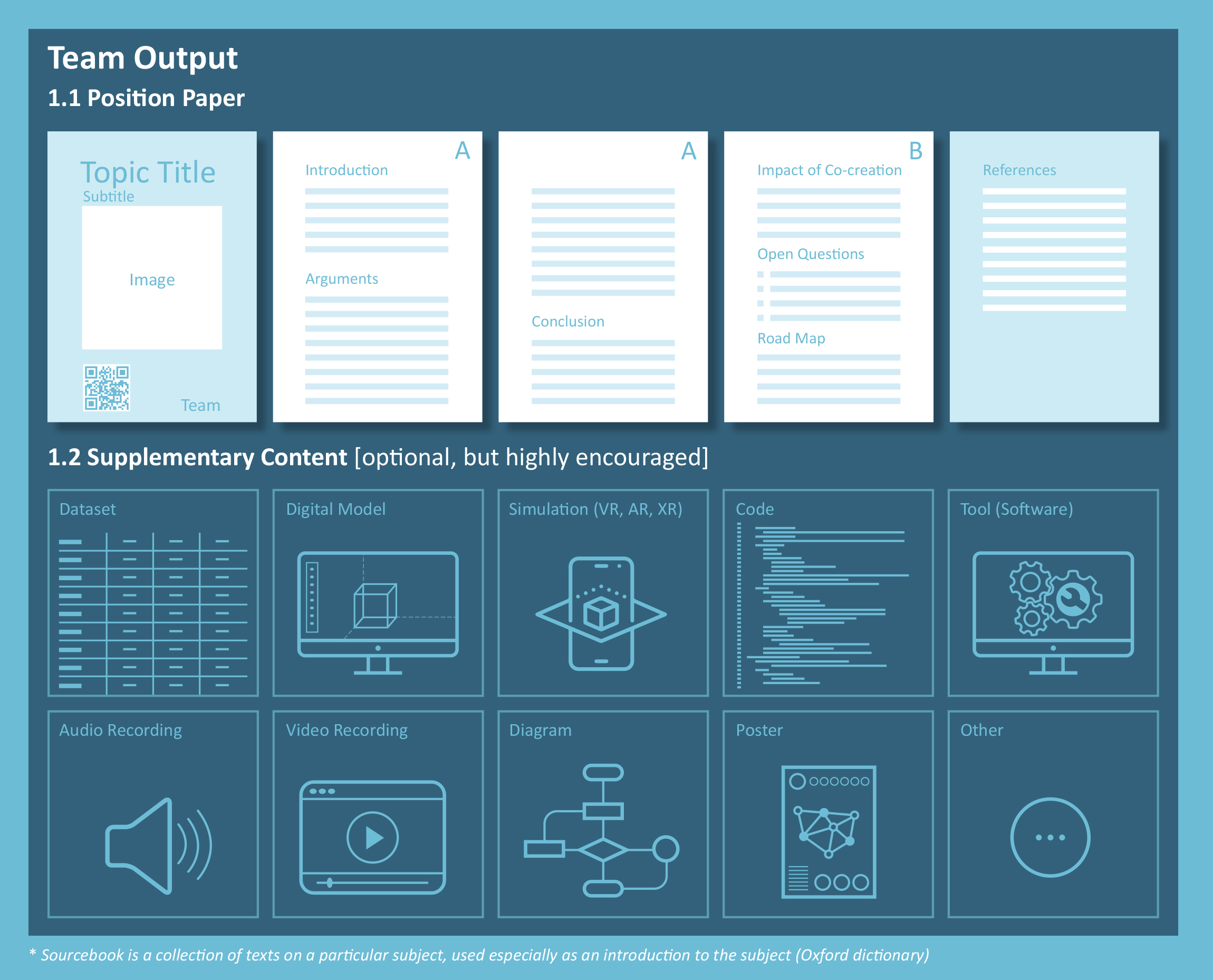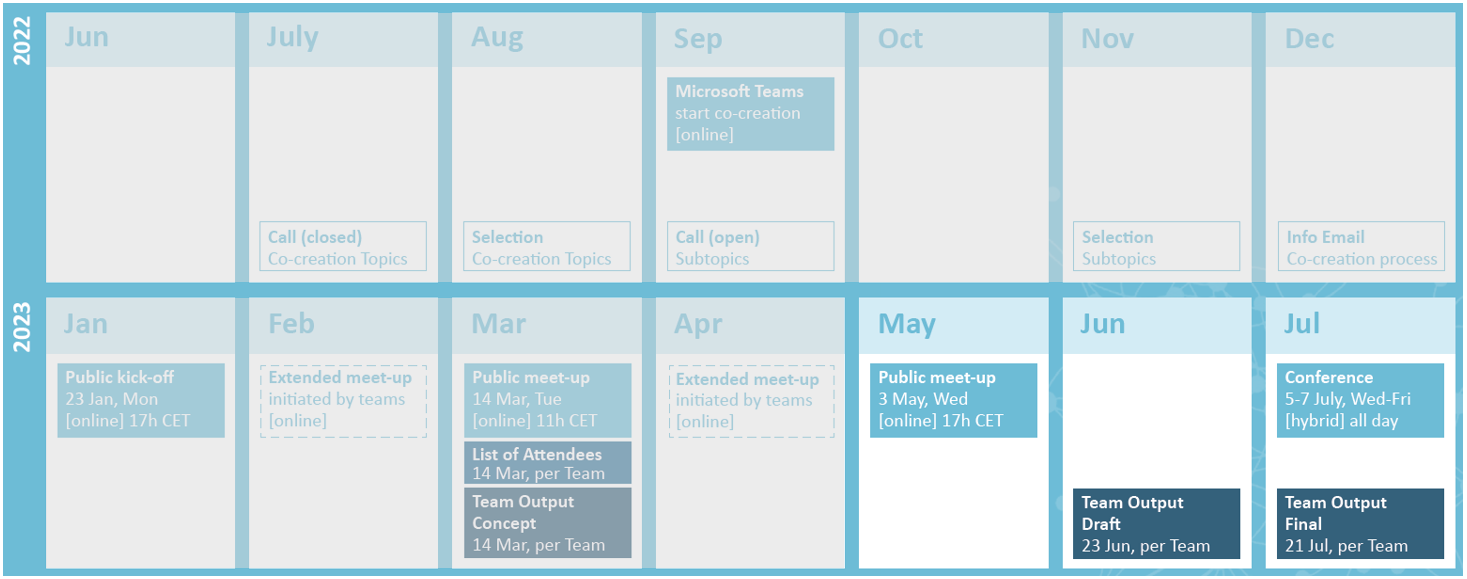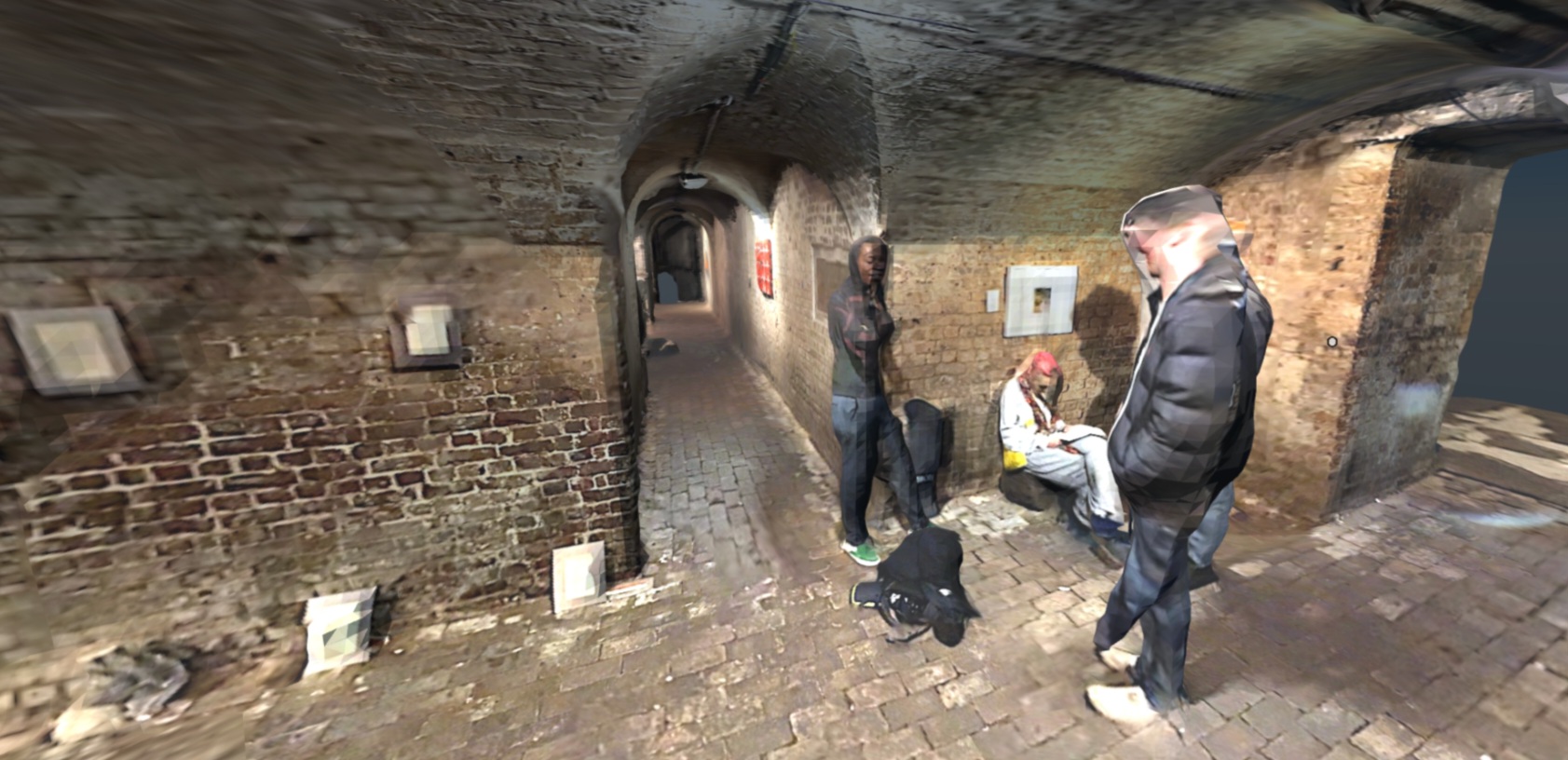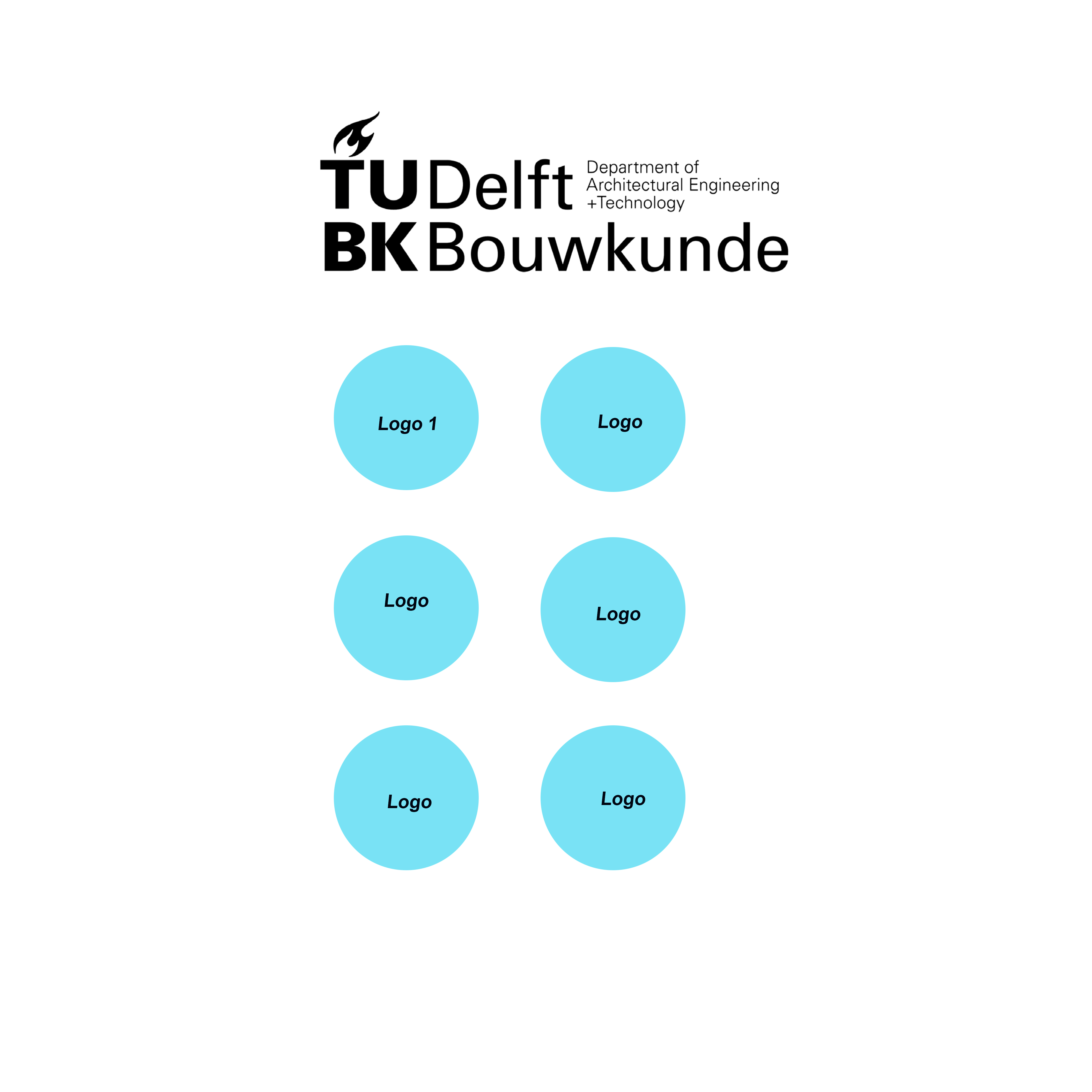Co-creation [page being updated]
Encouraged by the CAAD Futures Board, CAAD Futures 2023 introduces the Co-creation processes to collectively discuss research urgencies and their roadmaps, with a focus on the role of computation to interconnect in and for Architectural Design. Different Teams work on different Topics online and at the conference. This page hosts an overview on the Co-creation process. Scroll down for more info on:
Process | Open Access Sourcebook | Past events | Upcoming events | Co-creation Topics and Teams
General info on the Co-creation Process
The Co-creation journey started in June 2022 with the call for Topics. Eleven Topics were selected, each one proposed by a Team of experts composed by scientists and/or professionals involving multi-disciplinary backgrounds. The Teams joined the CAAD Futures 2023 Co-creation platform to collaborate online based on shared discussions, datasets, elaboration of digital models and documents, and other online materials. Besides individual Team’s activities, a number of online events across Teams are occurring prior the conference. The conference will host the Co-creation presentations and working sessions, open to all conference participants. Each Team will present a draft position Paper and supplementary content. The inputs from the conference participants can be integrated in the revised version of the Paper after the conference, which is then submitted for publication.
Co-creation Sourcebook
The Co-creation Sourcebook is envisioned based on Open Science principles. It aims to collect the position Papers and supplementary content of each Team. Each position Paper summarizes the co-creation content with focus on the elaboration of the topic, including a short introduction, arguments and a conclusion; and the co-creation process with focus on the impact of co-creation on the development of the topic, open questions and future roadmap. Each position Paper links to supplementary content, e.g. a dataset, code, a digital model (simulation, prototype), an immersive environment (VR, AR, XR), an audio/video recording, a 2D/3D image, a poster, a diagram (flow chart, infographic, etc.), a tool (software) or any other type of material that could contribute to the understanding of the topic. The supplementary content delivered for publication by each Team will be stored in an online repository and integrated in the ‘Co-creation Sourcebook’ by means of e.g. a QR code. (Note: Different options are explored for the front-end granting open access to the supplementary content. Its level of development will depend also on the resources available, which are under assessment).
The Co-creation Sourcebook intends to adhere to Open Science principles. This includes:
Open Peer Review: Prior publication, a peer review process takes place. The peer review process is planned with disclosed reviewers' and authors' identities and offering the opportunity to integrate the reviewers’ feedback in the co-creation output, with open acknowledgement.
Open Access: The Co-creation Sourcebook is planned to be published Open Access, under the Creative Commons license - Attribution Share Alike 4.0 International (CC-BY-SA).
Subject to final confirmation in due course, the Co-creation Sourcebook is planned to be published in Stichting OpenAccess Platforms (SOAP). Stichting OpenAccess is a non-profit foundation based in Rotterdam (NL), hosting open access e-print, pre-print, conference proceedings, book and journal archives (where the open access label refers to CC-BY-4.0 for all submitted, accepted and published publications).
Upcoming Events
For Co-creation Teams: 23 June 2023 is the internal deadline for each Team to submit the Draft Position Paper and related Supplementary Content.
Past Events
Following the Call for Topics, eleven Topics were selected in August 2022. The Teams of the selected Topics joined the Co-creation Platform in September 2022. After joining the platform, each Team could work online by sharing material and discussions. A kick-off meeting held online on 23 January 2023 initiated the joint events program. During the kick-off meeting, Stefanie Jansen addressed the concept and principles of the Co-creation method through an informative and motivating talk. On 14 March 2023, a online meeting across Teams took place with the aim of creating a platform for discussion and potential synergies between the different teams. Representatives of several Teams presented a 5-minute pitch of their topic and their expectations about the level of interaction with the audience during the Co-creation day. Several Teams initiated own (extended) meet-ups in April 2023. On 3 May 2023, an online meeting across Teams took place aiming to share updates across Teams and with the Conference Organizers. This meeting was the last online gathering across Teams before the actual conference on 5-7 July 2023 and thus served also to discuss several organizational aspects. The meeting benefitted from the active participation of Prof. dr. Gabriela Celani (President of CAAD Futures) and dr. Frank van der Hoeven (Director of Research of the Faculty of Architecture and the Built Environment and programme manager Open Science at TU Delft).
Co-creation Topics and Teams
|
TOPIC 1 - Participatory Design in the Metaverse for Sustainable Habitats Participatory Design is a design approach that focuses on collaboration and co-creation, which involves both expert and general intelligences in decision-making processes, with the aim of synthesising top-down and bottom-up approaches in design. Contextualised in sustainable habitat production, this topic problematizes traditional client-contractor modes of exchange through participatory methods, while exploring alternative stakeholder-driven models and how emerging Metaverse tools may assist or fail in the process. With the aid of digital and 3-dimensional communication tools, how can we transform the roles of architects and citizens from being passive consumers of architectural and construction services, to active contributors on the daily life of a city? Provides Ng, The Chinese University of Hong Kong, CN & Bartlett School of Architecture (UCL), UK | Architectural & Urban Research || Alberto Fernandez, Bartlett School of Architecture (UCL), UK & University of Chile, CL | Computation in Architecture || Hira Zuberi, Habib University, Karachi, PK | Participatory Design || Yanzi, RealtimeUK, UK | Computer Graphics & Animation || Artem Konevskikh, independent AI engineer, RU | Maker & Coder || Eli Joteva, Houdini.school & Drexel University, US | Intermedia Art || David Doria, Automated Architecture (AUAr), BR | AI in Architecture || Contact person: Provides Ng |
|
At the Conference, this Co-creation Session invites participants to discuss public space design within social housing, which are potent places in facilitating public life. Participants would be navigating VR scenes made with 3D scans of social housing in Asia, America, and Europe. These contexts vary in terms of density, scale, customs, and traditions. Participants would be informed with histories of the sites, design intentions and planning cultures, and most importantly, the events that were captured in the 3D scans as part of the public space. Participants would be taken on a journey together through these spaces; at each scene, we would stop and discuss - a volumetric roundtable. - Team 1 |
|
|
|
Sub-TOPIC - Housing customization approach by generative design and immersive visualization The need to adapt houses to the preferences of their inhabitants is a topic that architects have been concerned with for a long. This topic was fully discussed in the 50s and 60s by authors such as Hansen, Hundertwasser, Maki, Habraken, Turner, and others. Today this discussion continues, and several participatory practices are now recognized as the ones of MVRDV and Elemental offices, although their action is limited. In this sub-topic, we propose a discussion on the potential of a design tool that gives inhabitants the means to design housing customization solutions and is created by architects to generate solutions that satisfy the architectural rules of the housing. Such tools, by using generative design strategies, enable inhabitants to customize their houses according to their desire and needs and to a given architectural language. Additionally, to the generative power of such tools, the opportunities brought by metaverse enable quick and full simulations, new collaboration, and interaction possibilities within the design process. New implementations of technologies such as virtual and augmented reality and decreasing prices are reasons to anticipate wide use in the near future. Examples are metaverse BigWorld concept (from Zaha Hadid architects), a virtual space where potentially citizens could access and co-create their built environment. Sara Eloy, Instituto Universitário de Lisboa, PT | Architecture || Maria Lopez, MVRDV, NL | Architectural Practice || Micaela Raposo, Instituto Universitário de Lisboa, PT | HCI in Architecture || Marcos Figueiredo, Instituto Universitário de Lisboa, PT | Product Design || Nuno Pereira da Silva, Instituto Universitário de Lisboa, PT | Robotics in Architecture || Pieter E. Vermaas, TU Delft, NL | Philosophy || Contact Person: Sara Eloy (sara.eloy@iscte-iul.pt) |
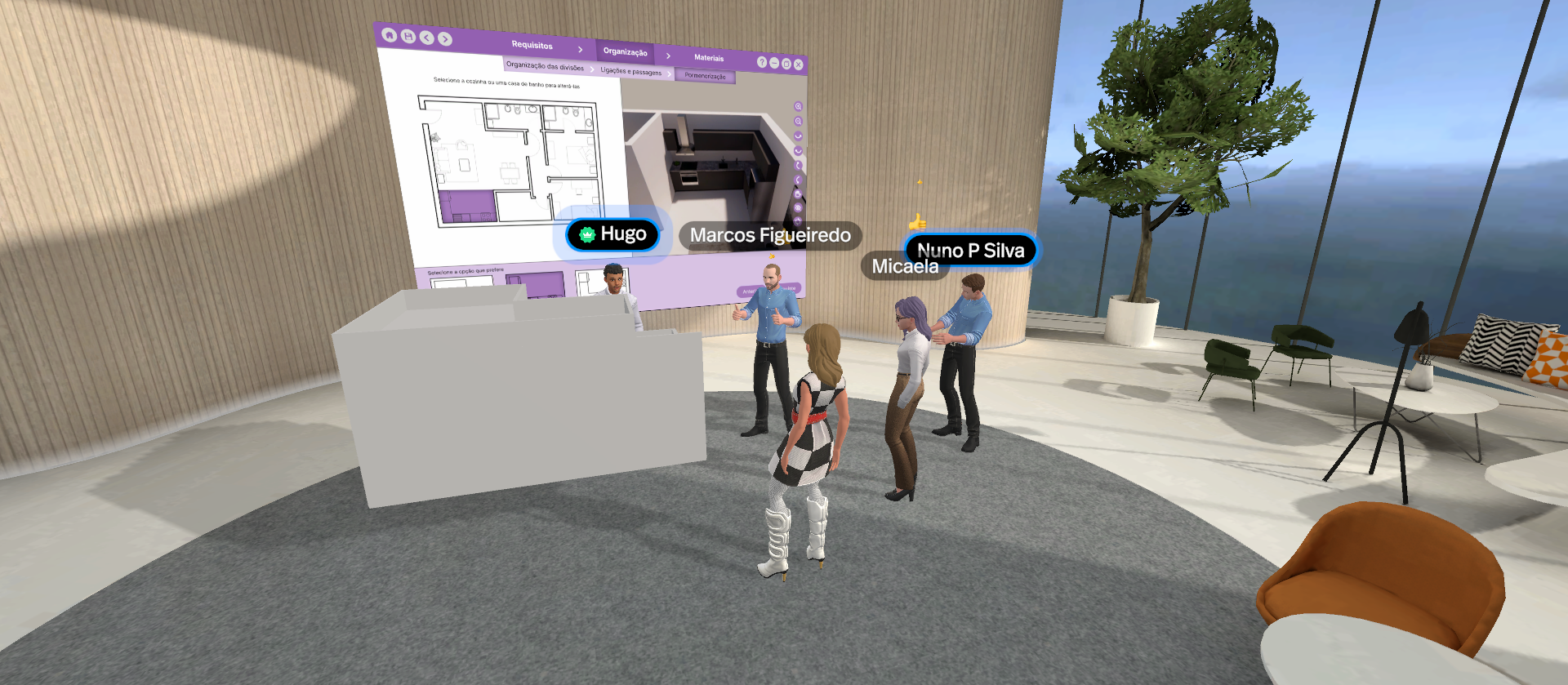 |
|
TOPIC 4 - Machine Learning Data for Architectural Design. Artificial Intelligence (AI) is the most promising technology to transform ever-increasing data into valuable knowledge, upon which decisions and actions are made to resolve the world's biggest challenges. In accordance, AI in architecture is progressively used to analyze the built environment, while the informed-design decisions are further supported by intelligent modeling tools. To develop state-of-the-art AI for architectural design, extensive and reliable data is the key, due to the data-driven nature of modern AI. In this co-creation event, AI experts and designers exchange ideas to approach “data sparsity” problem when it comes to the machine learning datasets for AI in architecture. Seyran Khademi, TU Delft, NL | Computer vision and AI || Casper van Engelenburg, TU Delft, NL | Computer vision and AI || Fatemeh Mostafavi, TU Delft, NL | Building Technology || Özgün Balaban, Istanbul Technical University, TR | Computational Design || Theodore Galanos, University of Malta, MT | Intelligent-Driven Design || Zack Xuereb Conti, Alan Turing Institute & University of Cambridge | Physics-enhanced Machine Learning || Contact person: Seyran Khademi |
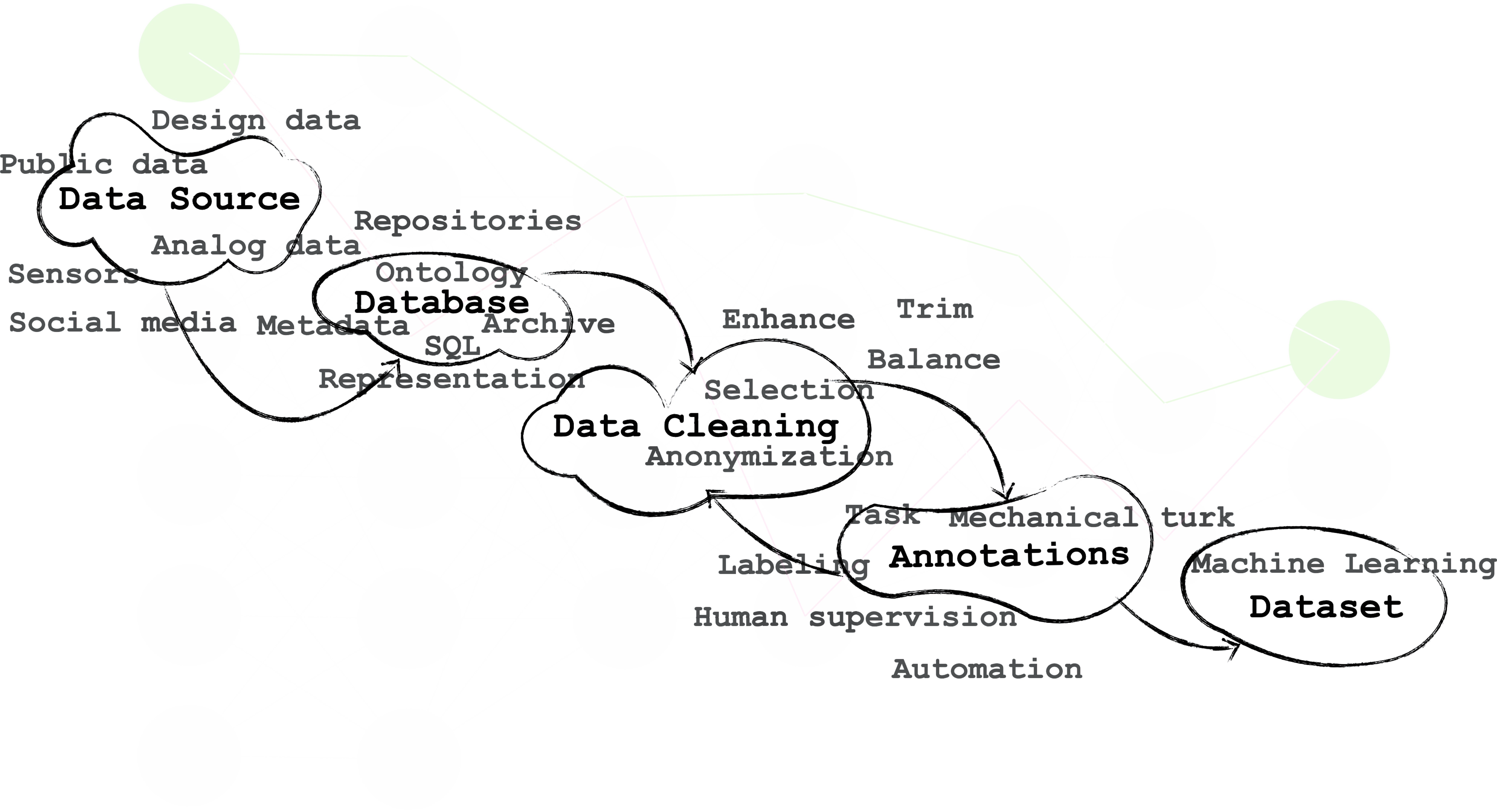 |
|
TOPIC 6 - Information Management across the Lifecycle of 3D Objects. The need to exchange data between the various stakeholders of the Spatial Development Lifecycle (SDL) creates the requirements for structuring and organising the related spatial data into an efficient and standardised data flow. Current practice has shown that all the actors work independently, using custom-made methodologies and tools, resulting in data loss, duplicates, time and cost increase. How can we use standards to structure and facilitate the data reuse? Is there a cultural difference in the (open) data sharing between the GIS and design/ BIM domain; how much does it influence the quality of data? This topic explores the current situation as described below and discusses the requirements to support the data circularity within the Digital Built Environment using standards. Eftychia Kalogianni, TU Delft, NL | 3D Land Administration Systems || Peter van Oosterom, TU Delft, NL | 3D Land Administration Systems || Efi Dimopoulou, National Technical University of Athens, GR | 3D Cadastre || Jesper Paasch, Aalborg University, DK | Spatial Information Modelling || Abdullah Alattas, King Abdulaziz University, SA | Indoor Modelling and Navigation || Jörg Blankenbach, RWTH Aachen University, DE | Digital Twins || Contact person: Eftychia Kalogianni |
|
At the Co-creation Session, we invite participants to join an interactive session to share experience and methodologies of reusing data from various phases of the Spatial Development Lifecycle (designing, permitting, constructing, registering, etc.). The session will capture the several standards that are being used in such a process, the difficulties encountered today in various countries and the differences in the culture of sharing information between the GIS and the design domains. Participants will be invited to take part in poster session to answer the main questions that will be generated from the roundtable discussion. Topics regarding the need to adjust students’ curriculum to grow the data sharing mindset, as well as draft guidelines to support a top-down approach on this topic will be discussed. Through co-creation additional narratives will emerge from the dialogue and participants will be welcome to contribute to the final paper. - Team 6 |
|
TOPIC 7 - Computational Design: a mandatory skill or a specialized role in the AEC? The need for digitizing the entire process chain in the AEC industry has created requirements for a computational designer. However, with the advent of such a specialist role, the industry is struggling to categorize it either as a content specialist or a process specialist. Therefore, the main aim of this discourse is to investigate and define the role of computational designer in project teams and design process. The purpose of the debate is to understand the different perspectives of the industry experts regarding computational designers through open discussions. The study will support the increasing demands of industry stakeholders concerning efficiency, flexibility, speed and quality of a design process to deliver better informed design solutions. Pieter Schreurs, Royal Haskoning DHV, NL | Computational Design || Anagha Yoganand, Royal Haskoning DHV, NL | Computational Design || Ginevra Nazzarri, Royal Haskoning DHV, NL | Computational Design || Gijs Joosen, Royal Haskoning DHV, NL | Computational Design || Contact person: Pieter Schreurs (Pieter.Schreurs@rhdhv.com) |
| On the co-creation day, we invite you to join two interactive 60-minute sessions that will explore the role of a computational designer in the AEC. Engage in a thought-provoking round table discussion where we tackle industry's pressing questions: How can computational designers drive broad-scale adoption? Should they be discipline experts or embrace a generalist role? Discover persuasive strategies to win over traditionalists. Then, brace yourself for an interactive workshop that will focus on role definition and the maturity levels for a computational designer in practice. - Team 7 |
 |
|
TOPIC 8 - Are graphs the new BIM? The way knowledge is represented influences how the design is explored and analyzed. Current object-oriented data models are rich in terms of semantics and geometric information; however, relationships between data as well as data validation or reasoning are not the primer goal of such models. In this session, we will elaborate on graph data models as an extension to current object-oriented building information models. We will investigate several topics, including data modelling strategies, data interoperability issues, co-design with graphs, evaluation of graph data models for the AEC industry, data federation, etc. Furthermore, we will elaborate on graphs' complex queries that can help recognize violated design constraints from the early design stages. Diellza Elshani, University of Stuttgart, DE | Knowledge Graphs || Thomas Wortmann, University of Stuttgart, DE | Computational Design || Pieter Pauwels, Eindhoven University of Technology, NL | Linked Building Data || Michela Turrin, TU Delft, NL | Computational Design || Wassim Jabi, Cardiff University, GB | BIM || Greg Schleusner, Director of Design Technology HOK | Computational Design || Jeroen Werbrouck, Ghent University, BE | Federated data storage || Navid Hedayati, Gropyus, DE | BIM || Edlira Kalemi Vakaj, Birmingham City University, GB | Semantic Web Technologies || Tanya Bloch, Technion - Israel Institute of Technology, IL | BIM || Guy Austern, Technion - Israel Institute of Technology, IL | Machine Learning || Esra Bektas, TNO, NL | Knowledge Modelling || Peter Bonsma, Technical Director at RDF, BG | Mathematical algorithms || Ayda Grisiute, Singapore-ETH Centre, SG | Trans-disciplinary urban research || Pieter Herthogs, Singapore-ETH Centre, SG | Trans-disciplinary urban research || Ranjith K. Soman, Delft University of Technology, NL | Construction Informatics || Patrick Janssen, Head of Research at Packhunt, NL | Computational Design || Al Fisher, Buro Happold, UK | Computational Design || Alessio Lombardi, Buro Happold, UK | Interoperability, Machine Learning || Aaron Wagner, University of Stuttgart, DE | Computational Design || Contact person: Diellza Elshani |
 |
|
TOPIC 9 - AEC Decentralised Autonomous Organisations. The Architecture-Engineering-construction Decentralised Autonomous Organisations aim to change the AEC industry from a resource extractive, fragmented, unproductive industry into a productive, integrated, regenerative industry. This topic of co-creation will explore the structure, impact and immense potential that blockchain technologies have in having an impact within the AEC space, more so when questions of permanence and digital scarcity are ever more urgent in the industry as we see the emergence of the metaverse as a field for architects to structure new spaces for human activity. Theodoros Dounas, ArchiDAO.io & Robert Gordon University, GB | Blockchain || Davide Lombardi, Xian Jiaotong Liverpool University, CN | Parametric Systems and Optimisation || Shree Laxmi, Bitcrunch & ArchiDAO.io | Metaverse || Simon Prokop, Czech Technical University of Prague, CZ | Generative and Parametric Systems || Jiri Vele, Czech Technical University of Prague, CZ | 3D Printing || Mayur Mistry, Perkins and Will, US | AEC Digital Strategies || Richa Gupta, ArchiDAO.io | Decentralised Autonomous Organisations || Daniel Hall, TU Delft, NL | Innovative and Industrial Construction || Jens Hunhevicz, ETH, CH | Blockchain and Cryptoeconomics in AEC || David Bucher, ETH, CH | Management and Construction || Wang Hongyang, ETH, CH | Integrated Building Systems || Contact person: Theodoros Dounas |
|
TOPIC 10 - Algorithmic Community Construction. What is the potential for shared construction to create community? What factors impact this construction of these physical assemblies and communities? What is the impact on the space and the participants afterward? Is there an “identity” which arises for participants as agents of the physical and social results of the collaboration? This Co-Creation brings together four practitioners who seek to create community through shared construction of physical spaces / objects following algorithmic rules with a respondent to drive an examination. It is hoped that a greater understanding of the creation of community and individual identity through construction will be gained. Duane McLemore, Mississippi State University, US | Algorithmic Design || Molly Claypool, AUAR & The Bartlett School of Architecture, GB | Algorithmic Design || Gilles Retsin, AUAR & The Bartlett School of Architecture, GB | Algorithmic Design || Xavi Aguirre, Stock-a-Studio & Massachusetts Institute of Technology, US | Standardization and Customization || Emmanuelle Chiappone-Piriou, Technische Universität Wien, AT | History, Theory, and Criticism || Contact person: Duane McLemore |
|
At the Conference, in this Co-creation Session: "The Co-Creation Group Algorithmic Community Construction highlights how the same algorithmic rules that facilitate automated fabrication can be utilized to allow untrained participants to work together in realizing an architectural installation. It examines how these efforts create a community of those participating. The Co-Creation Group will display examples of this work through oral histories from the projects’ designers / facilitators, a “Source Book” of the methods used and reflections on their processes, and (funding permitting) a participatory installation for conference attendees. The displayed work will explore the history, theory, and methods of this mode of practice which bridges the analog and digital. - Team 10 |
 |
|
TOPIC 11 - Incremental Media Empowerment: Establishing Voice through Communication Narratives. The architectural profession is driven by research and data, architects tasked with making informed decisions with regard to a confluence of factors, motives, and needs. To understand the breadth of considerations, architects must communicate both verbally and graphically with a wide variety of audiences, and piece together information related to clients, investors, developers, users, community members, and political actors. There are a wide array of media that professionals use to conduct research, communicate with involved parties, and synthesize information to inform their design. Given the breadth of other skills and education objectives across the architectural curriculum, what is the priority of research and data synthesis within design education? Michelle Pannone, Marywood University, USA | Digital Media and Fabrication || Margaret McManus, The Savannah College of Art and Design, USA | Design Systems and Representation || Randy Damico, Ferris State University, USA | Parametric Design and Fabrication || Kimberley Hagan, Marywood University, USA | Material Life Span and BIM || Kate O'Connor, Ferris State University, USA | Representation and Beginning Design || Rebecca Dolgas, Rhode Island School of Design USA | Representation and Adaptive Reuse || Meghan Strevig, Rhode Island School of Design USA | 3D Visualization and GIS || Lisa Phillips, Thomas Jefferson University, USA | Immersive Technology and Visualization || Charlie O'Green, University of Michigan, USA | Alternative Material Systems and Fabrication || Victoria Farrow, De Monfort University, UK | Beginning Design, Representation and BIM || Contact person: Michelle Pannone mpannone@marywood.edu |
|
At the conference, we invite participants to join an interactive co-creation session to share methodologies of integrating data and research in student work. This session will capture various pedagogical approaches that experiment with the role of media and technology in engaging Communication Narratives through the various stakeholders that projects in the built environment encounter. Participants will be invited to take part in drawing connections between various methodologies (approaches to projects, workshops, courses) presented in the dynamic Case Study Library. Through co-creation additional narratives will emerge from the dialogue and participants will be welcome to contribute to the collection. - Team 11 |
 |
 |
CAAD Futures 2023
 Registration website for CAAD Futures 2023
Registration website for CAAD Futures 2023CAAD Futures 2023cf2023@tudelft.nl
CAAD Futures 2023cf2023@tudelft.nlhttps://www.caadfutures2023.nl/132056
2023-07-05
2023-07-07
MixedEventAttendanceMode
EventScheduled
CAAD Futures 2023CAAD Futures 20230.00EUROnlineOnly2019-01-01T00:00:00Z
TU Delft Faculty of ArchitectureTU Delft Faculty of ArchitectureJulianalaan 134 2628 BL Delft Netherlands

